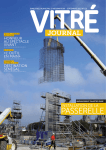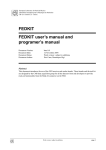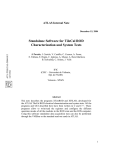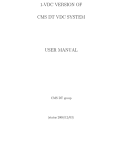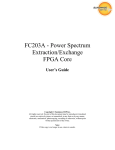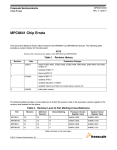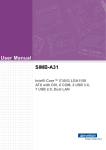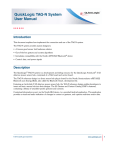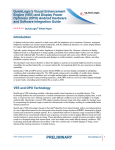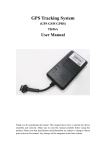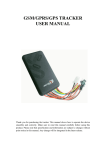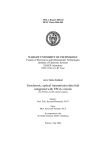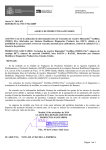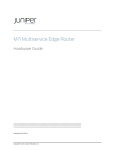Download EMU FED - Physics - The Ohio State University
Transcript
EMU FED --- Crate and Electronics B. Bylsma, S. Durkin, Jason Gilmore, Jianhui Gu, T.Y. Ling The Ohio State University ESR, CERN, November 2004 EMU FED: Outline • EMU FED Design • FED Crate & Custom Backplane • DDU Functions and Tests • DCC Functions and Tests • Data Flow Control • FED Production Preparation GU, EMU FED ESR, November, 2004 2 EMU FED: EMU FED Design Gb/s Fibers Myrinet 5Gb/s Fibers SLINK64 CMS DAQ TMB Peripheral DMB CFEB FRL FED USC55 ALCT AFEB Detector GU, EMU FED ESR, November, 2004 540 DMB as inputs (160MB/s) 8 SLINK64 as outputs (800MB/s) Expected data rate 1.2 GB/s 3 EMU FED: EMU FED Location GU, EMU FED ESR, November, 2004 4 EMU FED: EMU FED Design • Four 9U Crates 9U X 220mm Board • Data Concentration: D C C DDU 15 DMB to 1 DDU 9 DDU to 1 DCC 1 DCC to 2 SLINK64 DDU 9 DDU per SLINK (4) 4/5 DDU per SLINK (8) 2/3 DDU per SLINK (16) 1 DDU per SLINK (36) 36 DDU, 4/8 DCC needed Base-line design Optional The crate will be a standard 9U crate with minor modification GU, EMU FED ESR, November, 2004 5 EMU FED: EMU FED crate backplanes P1: Standard VME64x, for slow control P2: empty P3: custom for TTC control and Fast data transmission between DDU and DCC 6.4 Gbps rated connector Data from DDU to DCC TTC control bus GU, EMU FED ESR, November, 2004 6 EMU FED: DDU Prototype VME FPGA DMB Input FPGAs 4 Input FIFOs GBE FIFO XILINX Virtex2-500 2 XILINX Virtex2Pro-20 512 KB each 1024 KB 9U VME board, 220 mm depth FMM output port 15 Optical fiber inputs (just 1 for now) DDU Control FPGA Gbit Ethernet Output XILINX Virtex2Pro-7 To Local DAQ GU, EMU FED ESR, November, 2004 SLINK Mezzanine board connector 7 EMU FED: DDU Plan FMM & Slow Control VME FPGA FIFO FPGA FPGA FIFO Transceivers GU, EMU FED ESR, November, 2004 TTC control from DCC via backplane MGT-HSC Fiber links from 15 DMBs FPGA •BUSY •READY •L1 Throttle •Data Errors •Loss of Synch Slow-control and JTAG DCC/DAQ Multi-Gigabit Transmission via HighSpeed Connector to backplane S-Link (for SP use) Gigabit Ethernet To Local DAQ 8 EMU FED: DDU Design (1) • DDU Functions – High-Bandwidth data concentration and buffering • 13 DMB B DAQ via DCC, capable of continuous 600+ MB/sec rate • Parallel data readout via Gigabit Ethernet (local DAQ path) – Full error checking and status monitoring • CRC check, word count, L1 number, BXN, overflow, link status – FMM communication path for EMU DAQ • DAQ Buffer capacity – Average EMU occupancy is ~3 CSCs with data per event at LHC • 8 Byte event header sent from DMB for empty “no data” events – Headers from empty events are zero-suppressed at DDU • A typical DDU “data event” has 3 kB at LHC • Average event size in the DDU is 450 Bytes – Each DDU has 2.5 MB buffer: 20% in FPGA BRAM, 80% in FIFO • Typically enough to hold 2000 events at LHC • Typical event process time ~1 µsec GU, EMU FED ESR, November, 2004 9 EMU FED: DDU Design (2) • TTC clock & control from DCC via backplane • Slow control via VME – Provides link to on-board serial/JTAG paths • Load firmware into on-board EPROMs • Load constants into on-board Flash memory – Warning thresholds, offsets and Board ID – Provides path for system-wide status monitoring • VME Controller can see “global overview” of all 36 DDUs • Allows fast detection/response for subtle effects GU, EMU FED ESR, November, 2004 10 GU, EMU FED ESR, November, 2004 11 EMU FED: DDU Performance • Oct. 2004 Beamtest results: no problems – Multiple DMB readout to DAQ • Good performance via DCC/S-Link and gigabit Ethernet spy path – Error-free operation at high rates • Muon rates at H2 beam up to 25 kHz • Passed all tests at 9-times LHC expected data rate • DDU buffer size is more than sufficient for LHC – Status/error monitoring • All checks performed as expected, verified in offline software • Verified consistent fast monitoring path performance GU, EMU FED ESR, November, 2004 12 EMU FED: DDU Testing Procedure • Receive board from assembly house • Load the VME_FPGA PROM • Load the DDU_Ctrl PROM • Load the InFPGA PROM • Read in the board ID from PROM user code • Every time after RESET, the DDU will be in a ready state • Before LHC run, download a BX_Number offset through VME slow control, so the BX_number will match between DDU, DMB and other peripheral crate electronics • EMU needs 36 DDUs plus spares GU, EMU FED ESR, November, 2004 13 EMU FED: DCC Function Each DCC serves 1/4 of EMU 9 DDU, 2 SLINK64 Data Concentration • Merge 10 DDUs data into two slink64, two optional gigabit spy path Fast Control • • Receive TTC fiber signals using TTCrx, send L1A CMS_clock and other TTC command to FED crate Optional FMM interface Slow Control • VME Slave Misc. • • • GU, EMU FED ESR, November, 2004 9U x 220mm VME slave +5V (<1A), +3.3V (~6A) Regulators for +2.5V, +1.5V, +1.5V 14 EMU FED: DCC Data Acquisition DDU0 DDU1 DDU2 3.2Gb/s 160MHz x2 3.2Gb/s x 40 IN_FPGA 3.2Gb/s VME 64X FIFO1 Em e rge ncy 160MHz x 40 x2 FIFO2 IN_FPGA 3.2Gb/s DDU3 DDU4 1Gb/s 160MHz x2 x 40 3.2Gb/s FIFO3 160MHz x2 x 40 125MHzDDR FIFO4 x 40 DDU6 3.2Gb/s FIFO5 x 40 160MHz x 40 x2 3.2Gb/s x 40 x2 x 64 3.2Gb/s FIFO6 160MHz x2 x 40 3.2Gb/s 160MHz DDU8 x 2 DDU9 3.2Gb/s x2 x 40 FIFO7 FIFO8 IN_FPGA 100MHz FIFO 125MHz x 64 1Gb/s IN_FPGA DDU7 125MHz 125MHzDDR 160MHz Gigabit ethernet SLINK64 x 64 M_FPGA IN_FPGA DDU5 Power 160MHz x 40 x2 FIFO0 100MHz FIFO SLINK64 x 64 Gigabit ethernet L1A CMSCLK control V ME control FMM 160MHz x 40 FIFO9 GU, EMU FED ESR, November, 2004 Backplane TTCrx TTC 15 EMU FED: DCC Few Extra features 9Mb FIFO to buffer the data from FPGA to SLINK transmitter: • This will keep the speed on data readout at 1GByte/s, and SLINK throughput at 800MByte/s • It serves as a storage, to even out the L1A fluctuation DDR FIFO keeps the same data rate using less number of wires. The DCC has the ability to combine the two sets of FIFO inputs and send the data to one SLINK transmitter. Data transmission backpressure: DMBFIFO FIFO DDU FIFO DCC FIFO SLINK TTS GU, EMU FED ESR, November, 2004 16 EMU FED: Data Back pressure When Slink is full, the DCC will stop sending data to Slink, the data will be buffered at the DCC S_FIFO, When the DCC S_FIFO is ‘Almost_full’, it will stop the DCC assembling events. The data will backup on the IN_FIFO; When the IN_FIFO gets to a certain point, it will backpressure on DDU, the DDU will stop sending data to DCC. The data will be backup on DDU; When DDU FIFO get to a certain point, it will backpressure the DMB, and send warning signals through FMM to TTS. If the DMB FIFOs will be monitored by DDU, and the DMB can also disable the trigger sending to CFEB in case the DMB FIFO close to full. If the TTS does not respond to DDU warning, the DDU will send data to DCC to prevent DDU FIFO get full, the DCC will only receive and process data header/trailer to prevent FIFO get full, and at the same time, keep the data package integrity. This mechanism should give sufficient time for TTS to respond. GU, EMU FED ESR, November, 2004 17 EMU FED: DCC Data Acquisition On L1A (Data is always sent on L1A) DDU sends data to DCC asynchronously (relative to L1A) DCC assembles data from DDUs into events and sends to FRL asynchronously LV1_ID(24), Bx_id(12) and Orbit_ID(32) are used to identify the event EMU DCC Event Size: no data ~300 bytes 1 CFEB ~3 Kbytes 5 CFEB ~10Kbytes Average ~2 Kbytes max_size 800 Kbytes DCC Data format: 63…60 59..56 55……………………………….32 31……………20 19……………8 7…4 3..1 0 Header 1: K 5 | Evty | LV1_ID (24) | Bx_id (12) | source_id |FOV|Hx$$ Header 2: K D | 9 | Orbit_ID (32) | FIFO_stat(16) | 9 | 7 Data Load D …………………………… Data Load D …………………………… ………………. Data Load D ……………………………. Trailer 2: K E | F | D_time(8) | DDU4(8) | DDU3(8) | DDU2(8) | DDU1(8) | DDU0(8) | FIFO_s(8) Trailer 1: K A | X | Evt_lgth(24) | CRC(16) | X | Evt_S| TTS| Tx$$ GU, EMU FED ESR, November, 2004 18 EMU FED: DCC Slow Control VME A24/D16 in VME64X P1 Backplane • A[23:19] match with GA[4:0] for specific slot, broadcast. • A[18:12] is used to address the different slow control paths (devices) • A[11:1] are specific to the given device A[18:12] device definition: 00: VME registers on the FPGA 02: JTAG for Controller PROMs 03: JTAG for IN_FPGA’s PROM 04: JTAG for IN_FPGA 05: JTAG for SLINK_A 06: JTAG for SLINK_B 07: TTCrx I2C interface 0F: Emergency load for Controller PROMs The DCC are always VME controllable even after FPGA ISPROM get SEU GU, EMU FED ESR, November, 2004 19 EMU FED: DCC Fast Control Custom Backplane carries all Fast control Signal Fast control signals TO the backplane (Bus_LVDS): • TTCrx on board, automatically select the TTC clock or the on-board oscillator as 40MHz source, four segments on the backplane • Automatically select TTC L1A, command bus or on board VME generation • The command bus and Data bus are switched, depending on the command_bus_strobe and Data_bus_strobe • Summary of backplane signals: Clock, L1A, Command_Strobe, Data_Strobe, Cmd_Dat_Bus(8), Hard_reset Fast control signals FROM the backplane (Bus_LVDS): • Clock, L1A, Command_Strobe, Data_Strobe, Cmd_Dat_Bus(8) Only one DCC is enabled for control signals to the backplane GU, EMU FED ESR, November, 2004 20 EMU FED: DCC Structure Beam Test Sept/Oct. 2004, H2 beams • TTC control – no issues • Backplane communications – no issues • Synchronization – no issue DCC rate tests carried out with high trigger rate. – 100 KHz L1A (TTCvi random trigger), >100 KHz LCT (lowering the comparator threshold to 2mV), FakeDDU sends 2.3KB per L1A, The DDU sending five chambers data, this gives >240MB/s data rate to SLINK. Check the L1A_number, Event size, 1/1000 write to disk and check synchronization offline. No Problem on DCC. GU, EMU FED ESR, November, 2004 21 EMU FED: DCC tests: Some issues On the DDR FIFO, there are internal cross talk from D22 to D21 line. Get around: do not use D21, we only need 33 bits out of 40bits on the FIFO. The DDR FIFO works at 125MHz reading speed, but the manufacture downgraded its rating to 100MHz. Solution: Even 100MHz (800MB/s) is good enough for our application (Slink ~200MB/s) At the CERN beam test, we do not have a readout system fast enough to handle the 200MB/s data, required by SLINK, this is not a real problem. GU, EMU FED ESR, November, 2004 22 EMU FED: DCC Bench test By plugging the DDU in different slot of the FED crate, all the ten DCC inputs are tested, and the two slink outputs are tested. Because the FED crate are in underground counting house, there is no need for radiation test and magnetic test ! GU, EMU FED ESR, November, 2004 23 EMU FED: DCC procedures • VME emergency load the Main_FPGA PROM • VME load the IN_FPGA PROM • The FPGA read in the board ID from PROM usercode • Load in the channel enable (DDU_in_use) • Every time after RESET, the DCC will be in a ready state • During LHC run, download a BX_number offset through VME slow control, or set the delay on the TTCrx, so the BX_number will match between DCC, DDU and peripheral crate electronics. GU, EMU FED ESR, November, 2004 24 EMU FED: Production preparation •How many boards do we need? DDU DCC DDU needed 36 + 1 Total (+ 20% spare) 45 4/5/9 DDU per Slink 4 ( 2/3 DDU per Slink 8 )* spare boards 2 Total boards producing 10 * This is just for very high data rate, requires 16 SLINK64 •The Ohio State University will maintain the DDU and DCC •some spare parts will be ordered in addition to the spare board for anticipated repair GU, EMU FED ESR, November, 2004 25 EMU FED: Production Test PC boards will be etched and stuffed commercially Boards will be measured and debugged on computerized tester before and after burn-in at OSU Each board will have a unique ID Board tracking: Microsoft Access To test the DDU: -Read DAQMB will be used as DDU input source, DCC as output destination -Check all inputs by moving fiber from connector to connector -Check Gigabit readout (spy path) by computer readout To test the DCC: -DDU signals mimicked by ‘fakeddu’ -Check all inputs by moving ‘fakeddu’ from slot to slot -Check all outputs by moving SLINK transmitter card After we have enough DDUs, the full FED crate will be tested GU, EMU FED ESR, November, 2004 26 EMU FED: Production Burn in Burn In CDF: 50-60 C for 8-24 Hrs Sufficient for tantalums failures No sensitivity to semiconductor failure US Military: 125 C for 320 Hrs Chip Makers recommend against this CFEB, DAQMB: 65 C for 24 Hrs Prove to be effective, not damaging Each DDU/ DCC: 65C for 24 Hrs Test Before and After GU, EMU FED ESR, November, 2004 27 EMU FED: Production Validation -First DDU was made in Jun. 2002 -Redesigned DDU was made in Jan. 2004 -Both boards are working reliably. -First DCC was made in Jan. 2004 -Second DCC was made in April 2004 with minor change -Both boards are working. The full production will be procured after full FED crate test DDU, DCC Meet Design Specifiations! We are ready to procure the DDU and DCC At The Ohio State University GU, EMU FED ESR, November, 2004 28 EMU FED: DDU & DCC Documentation http://www.physics.ohio-state.edu/~cms/ddu/ What is it? EMU DDU details DDU Operation General Hardware Info Technical Operation Details DDU Data Format http://www.physics.ohio-state.edu/~cms/dcc/ DCC User's Manual DCC ESR at CERN (Powerpoint) DCC PCB schematic design (pdf) DCC Data receiver FPGA design (latest version .svf) (pdf) DCC Slink interface FPGA design (latest version .svf) (pdf) DCC Output (Slink, Gigabit Ethernet) data format GU, EMU FED ESR, November, 2004 29





























